
Circuit-Bending is where I got my start as an instrument maker/modifier. I have since branched out to electro-acoustic, electronic, or purely acoustic instruments, but I still do quite a bit of bending. The first toy I ever tried to bend was a Casio MT-something, I don’t remember the model number as I sort of destroyed it. This was back in 1997-1998. I came to bending so excited, but this keyboard was a dud. Eventually I understood that some toys/keyboards don’t have much ‘juice’ as it were. This was one such keyboard. After a few months I gave it another go, and with a more fruitful bend under my belt, I was hooked.
This was before Ghazala’s excellent Book on Circuit-Bending, or mailing lists devoted to the subject or any real community, other than some discussion on the Oddmusic mailing list. At the time, armed with only a printed copy of Reed’s ‘How-To Circuit-Bent’ section from his webpage and Electronic Projects for Musicians, I poked, prodded, soldered, melted, twisted, and broke everything I could get my hands on.
I have now given a workshop on how to circuit-bend for The Noise Upstairs.
Below is a picture, a brief description, and soundfile/bending notes when available, of most of the instruments I currently own.
Yamaha DD-7
 The Yamaha DD-7 is probably the bent toy that I use the most. It was purchased specifically to be a bent addition to my acoustic drumset, but has become part of my ‘main’ travel setup of DD-7/SK-10/Melodica. The DD-7 has several relatively useful drum sounds and rhythms. The bends add different distortions, stutters, and overall glitches. It can also be pushed into chaotic pseudo-randomness very easily by applying several bends at once. The section on the top left controls a series of filters that are applied to whatever is happening at the time. The switches on the bottom left produce drones, one of a perma-stuttering bass drum, one of a stuttering “one” count-off.
The Yamaha DD-7 is probably the bent toy that I use the most. It was purchased specifically to be a bent addition to my acoustic drumset, but has become part of my ‘main’ travel setup of DD-7/SK-10/Melodica. The DD-7 has several relatively useful drum sounds and rhythms. The bends add different distortions, stutters, and overall glitches. It can also be pushed into chaotic pseudo-randomness very easily by applying several bends at once. The section on the top left controls a series of filters that are applied to whatever is happening at the time. The switches on the bottom left produce drones, one of a perma-stuttering bass drum, one of a stuttering “one” count-off.
 Here are my ‘bending notes’ for the DD-7.
Here are my ‘bending notes’ for the DD-7.
Yamaha DD-6
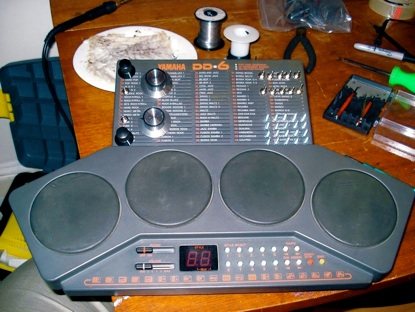
I decided to bend a Yamaha DD-6 after hearing how amazing Serg’s DD-6 bent came out. It’s very different from the DD-7 sound wise, primarily because the lack of a ‘drone’ switch on the DD-6. I went with two of the ‘filter bank’ bends, from the DD-7, with an amount control, and a 12-position switch (instead of 6-position).
I wired up the ten juiciest bends to dedicated switches. The rest of the bends were hooked up to a bolt-bay. This is the first time I use a bolt-bay in a toy. It works very well in this toy, particularly in conjunction with the normal bends.
 Here is a gut shot. I used thicker braided wire for the bolt-bay as the thin stuff wouldn’t stay put well.
Here is a gut shot. I used thicker braided wire for the bolt-bay as the thin stuff wouldn’t stay put well.
Here are Sergio Gato’s ‘bending notes’ for the DD-6, which I referenced for picking my points.
Page 1 (All Bends)
Page 2 (Bends Used)
Casio SK-10
The Casio SK-10. This was the fastest bend I’ve ever done. I originally modified it for Gilbert Kong, then guitarist in Failure, Arc of Beauty to use. I literally opened the toy, found five bend points, marked it, drilled it, wired it, and that was it. My wife, Angela, painted it.
The sounds it produces are somewhat atmospheric, typical of Casio SK keyboards. There is one bend that makes each key produce a rhythmic pulse of whatever note is played. It makes for very nice rhythm/textures when you play several notes at once.
Casio SK-5
 The Casio SK-5 is my go-to atmospheric keyboard. I modified this in a similar fashion to the SK-10, very quickly/casually. You can get lost for hours in the soundscapes it creates for. Unlike the SK-1, the SK-5 also has real drum sounds(as apposed to the ‘blips’ of the SK-1), and stores the samples while powered off.
The Casio SK-5 is my go-to atmospheric keyboard. I modified this in a similar fashion to the SK-10, very quickly/casually. You can get lost for hours in the soundscapes it creates for. Unlike the SK-1, the SK-5 also has real drum sounds(as apposed to the ‘blips’ of the SK-1), and stores the samples while powered off.
Casio SA-2
 The Casio SA-2 was one of my first bends ever. The original one died when I rehoused it into a watch tin. This is a second, cleaner one. I used higher quality switches/pots, as well as streamlining the bends I had built into it. There are two glitch buttons with pots, a reset, and three body contacts that produce theremin-like tones while making the SA-2’s tones move in a step-wise manner. The glitches produce anything from white-noise, to acid-jazz. A beautifully unpredictable instrument. I only wish it was louder.
The Casio SA-2 was one of my first bends ever. The original one died when I rehoused it into a watch tin. This is a second, cleaner one. I used higher quality switches/pots, as well as streamlining the bends I had built into it. There are two glitch buttons with pots, a reset, and three body contacts that produce theremin-like tones while making the SA-2’s tones move in a step-wise manner. The glitches produce anything from white-noise, to acid-jazz. A beautifully unpredictable instrument. I only wish it was louder.
Casio SK-1
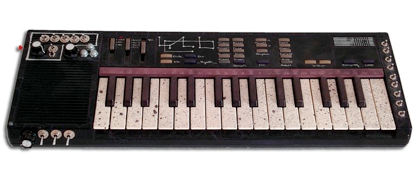 The Casio SK-1 is probably my biggest bending flop. I tried to copy Reed Ghazala’s SK-1 as described in his EMI article. To say it sounds horrible is an overstatement, as it still produces some interesting sounds. I just expected it to be my ‘ultimate’ keyboard, and this it is not.
The Casio SK-1 is probably my biggest bending flop. I tried to copy Reed Ghazala’s SK-1 as described in his EMI article. To say it sounds horrible is an overstatement, as it still produces some interesting sounds. I just expected it to be my ‘ultimate’ keyboard, and this it is not.
Demon Keys
 The Demon Keys sounds way cooler than it looks. It was made at the peak of my crackle paint days, hence the paint job. It produces strings of chance music similar to that of the SA-2, but draws from a completely different palette. Other than that it doesn’t sound interesting. I’ve mainly used this for recordings. I don’t actually remember what make/model this keyboard is since it’s all been painted over.
The Demon Keys sounds way cooler than it looks. It was made at the peak of my crackle paint days, hence the paint job. It produces strings of chance music similar to that of the SA-2, but draws from a completely different palette. Other than that it doesn’t sound interesting. I’ve mainly used this for recordings. I don’t actually remember what make/model this keyboard is since it’s all been painted over.
Speak & Math/Read
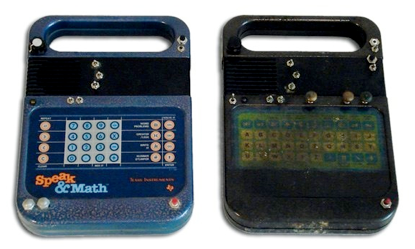 The Speak & Spell toys are staples of the circuit-bending worktable. They are interesting the first couple of times you hear them,. Other than, perhaps the loop function, these are unusably boring. I had a Talking Teacher that broke down, that produced similar text-based sounds, but in a more interesting way.
The Speak & Spell toys are staples of the circuit-bending worktable. They are interesting the first couple of times you hear them,. Other than, perhaps the loop function, these are unusably boring. I had a Talking Teacher that broke down, that produced similar text-based sounds, but in a more interesting way.
Morphiums
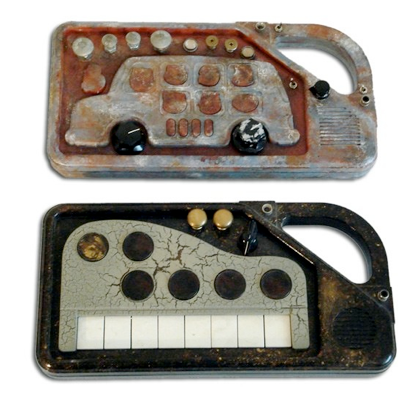 The Morphiums are from my early bending days. The industrial looking one is a body contact controlled animal/train sample bank. The space looking one is a boring, piano sounds toy. I had planned to build several bongo toys into it, but I couldn’t figure out how to wire up several toys to the same power supply.
The Morphiums are from my early bending days. The industrial looking one is a body contact controlled animal/train sample bank. The space looking one is a boring, piano sounds toy. I had planned to build several bongo toys into it, but I couldn’t figure out how to wire up several toys to the same power supply.



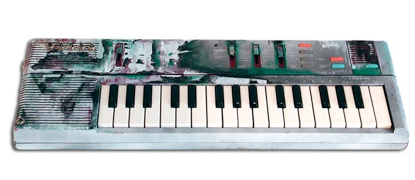
Awesome Job on those! I’m using Rodrigo’s notes on the DD6 right now.
i want to know wich is the integrated IC 4 name a friend gave a dd7 but not there the IC 4 thank i know you can say me the name or reference plz thank
They’d be the same I’m sure, on all DD7s.
I was wondering if you could explain your notes of the SK10? AL1-L6, I’m guessing are two connected points, but what is the designation of AL1 or L6? I don’t see them anywhere screenprinted on the component side of the PCB…
Thanks for any help!
So the two chips, which I’ve labelled A and B are the two main chips in there. I also drew another little chip so you can tell what orientation they are. Then for the actual label, so AL1 means, chip A, left side, first pin (from the top), connected to AL6 (chip A, left side, 6th pin down).
The rest of the notes are the same way.
ie glitch rhythm is : chip B, right side, pin 5, connected to chip A, right side, pin 9.
Hope that helps.
That does help a lot. Thanks, man.
The SA-2 Sounds are fucking amazing! Truly!
I have this SK-1 that I got for Chanukah when I was 12 – over 30 years ago – not bent – but barley workable – maybe I should bend it… also have this OLD Boss DR110 drum machine – had that since 84….
SK-1’s are super fun and easy to bend. Very worthwhile I’d say, if you don’t mind poking around at it.
Rodrigo thank you very much for you information and guides! The world needs more folks like you. Thanks to your notes I ended up finding a few new bends on the DD6 I had somehow missed before. I wish you well in life and health.